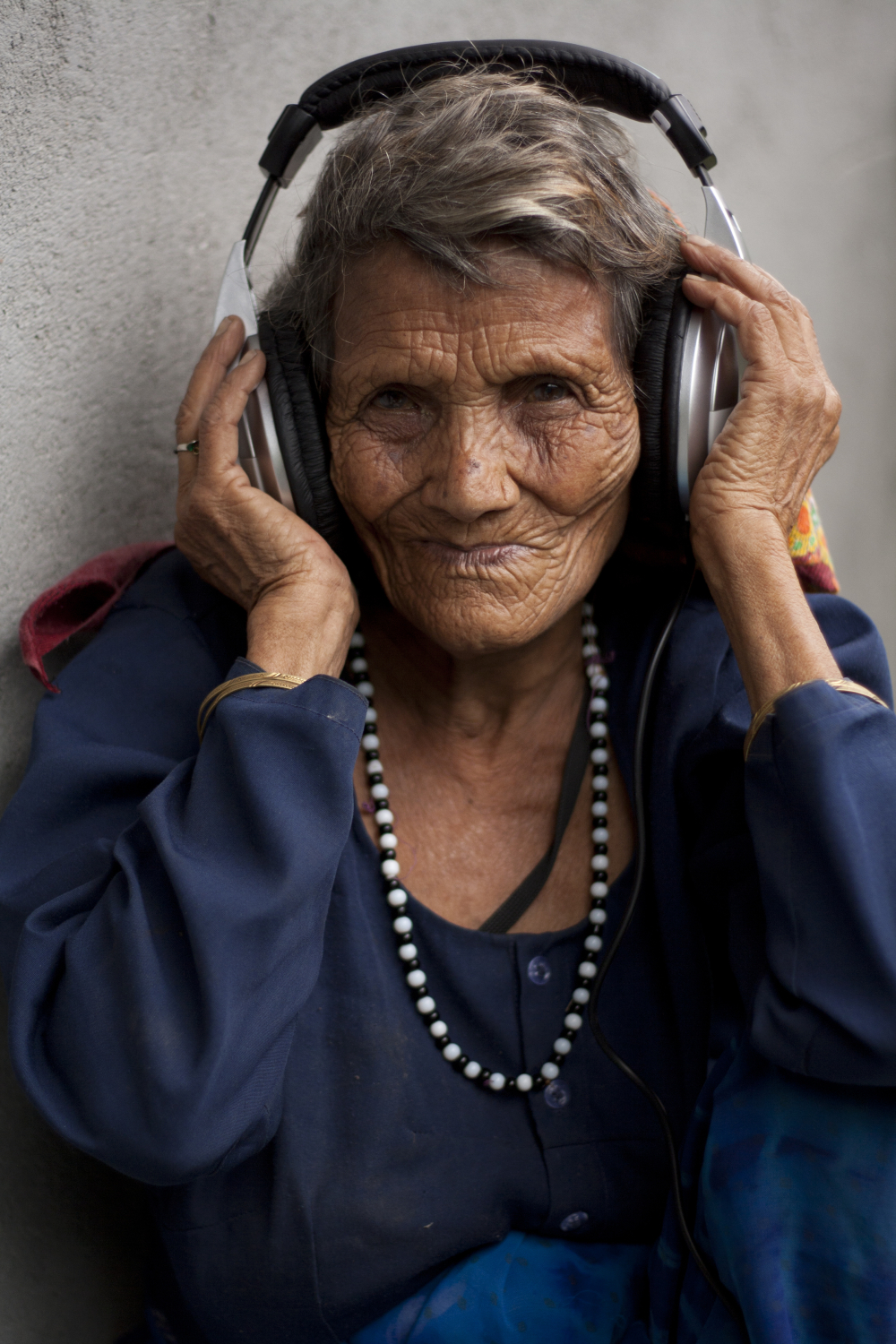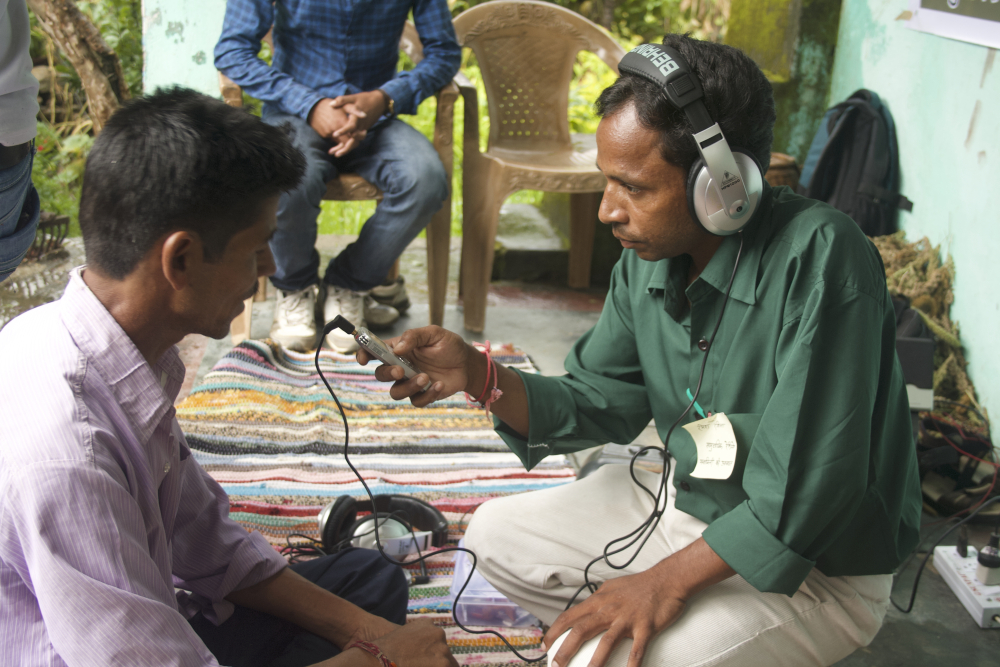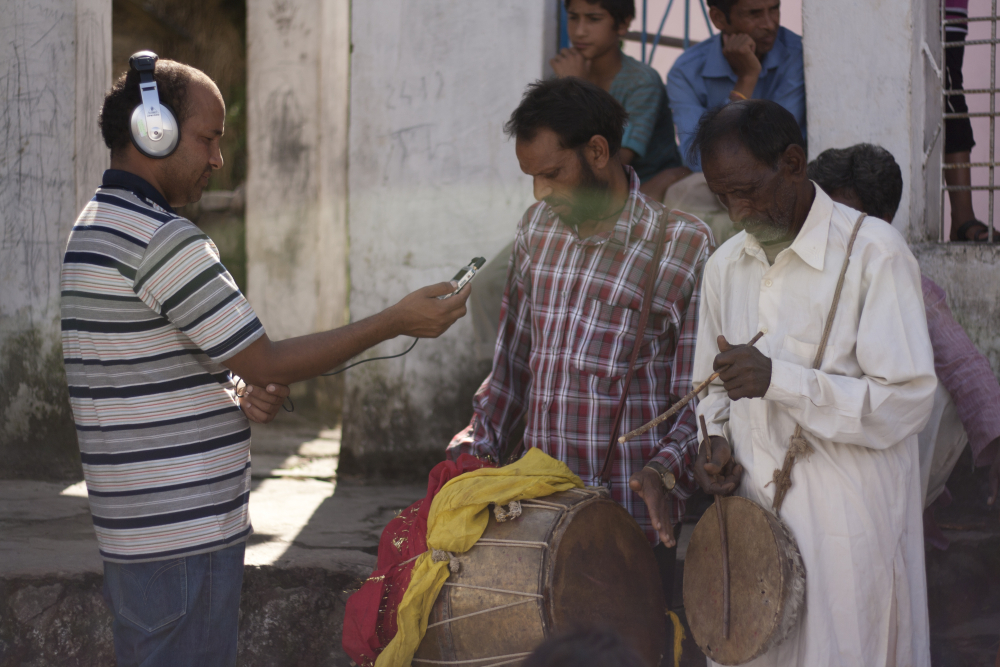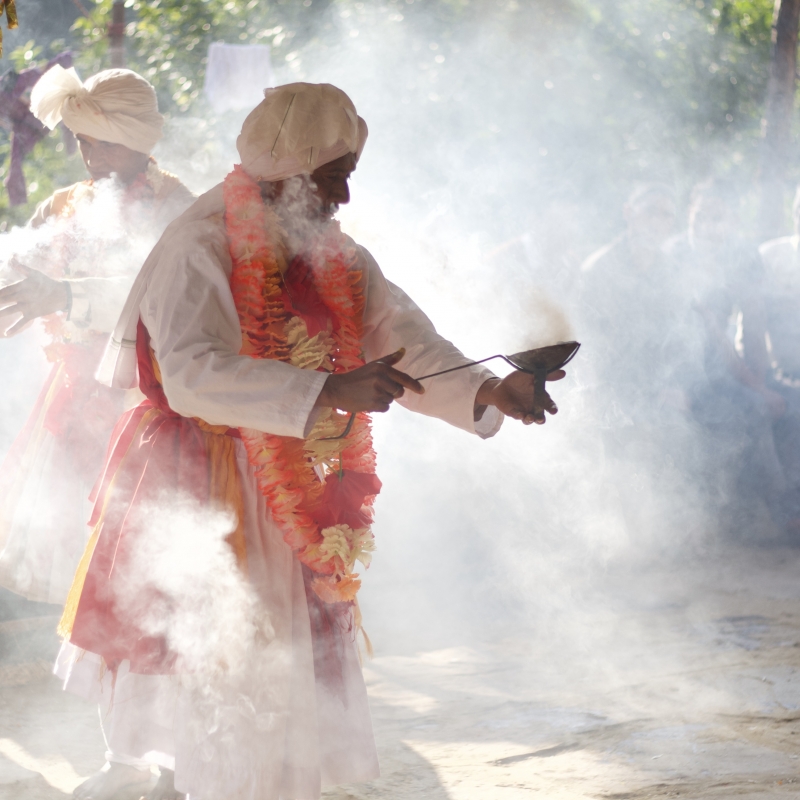Madhuri was 13 years old when she first met the Mandakini radiowalahs (radio people), as they were called in her village. They were a small group of three people from the Mandakini ki Awaaz radio station who had come to her village, Pinglapani, to record content—songs, stories, jokes—for the upcoming broadcast launch of the radio station.
An avid singer, Madhuri was encouraged by her neighbours and family to record something for the radio station. She sang a Garhwali song titled ‘Na Chhitti Ayi Teri’ (Your Letter Did Not Arrive) by Narendra Singh Negi, a doyen of Garhwali music in the region. A few months later, on September 21, 2014, the radio station crackled to life and Madhuri’s song began to play on air. Soon, the station was inundated with calls from community members requesting Madhuri’s song. Madhuri and her voice became popular among listeners in the radio’s catchment area within a span of a few days, transforming the young 13-year-old into a popular singer in the valley.
Nearly six years after the broadcast launch, Madhuri is now part of a growing group of local artistes (Fig. 1) in the Mandakini river valley, who are slowly and steadily becoming their region’s favourite musicians. The development has been facilitated by Mandakini ki Aawaz, which is Rudraprayag district’s first radio station.[1] A 1995 Supreme Court verdict which declared that airwaves were public property, inspired several communities to work towards building a community radio station of their own, but they had to wait until 2006 when the Indian government allowed community-run organisations and non-governmental organisations to run radio stations. In Garhwal, Manvendra Singh Negi, Devilal Bharati, and a few others decided to work towards building a community radio station for communities in the Mandakini river valley. They dreamed of a media platform that would provide information and entertainment in Garhwali, the local language marked by UNESCO as ‘vulnerable’ in its Atlas of the World’s Languages in Danger, as Negi, station manager and founding member of Mandakini ki Awaaz, shares in the documentary film, A Radio of One’s Own, ‘Whenever you listen to something that is close to you, whether it is your local information, music, anything in your native tongue—there is a sense of belonging.’[2] Their efforts came to fruition on September 21, 2014 when the community radio began broadcasting to over 3.5 lakh people in the Mandakini river valley at 90.8 MHz.

A Boon for Local Artistes
Garhwal is known for its rich and diverse cultural traditions; this region of Uttarakhand comprises seven districts, including Rudraprayag. Since its inception, Mandakini ki Awaaz was driven by the desire to give Garhwali artistes, musicians and performers a platform that was easily accessible and one that would help them reach out to a larger audience. In most villages, folk music traditions such as jagar (an all-night long ritual performance accompanied by dhol damaun [used collectively, they are drums made from copper, wood and animal hide] and daunri thaali [a plate like percussion instrument]), Bagadwali (a folk music tradition which chronicles the story of a local hero, Jeetu Bagadwal) and Pandwali (the music that accompanies Pandav Nritya, a dance based on the story of the Pandavas in Mahabharata) are kept alive by dedicated artistes who are rarely able to reach out to an audience beyond their immediate community. Their limitation is primarily due to economic constraints. Before the community radio station began broadcasting in the region, musicians from the region had to go to studios in the adjoining district of Srinagar or even further away to Dehradun or Almora to record music. Artistes often had to raise the funds required for renting the studio and musical equipment and to pay other accompanying musicians, the costs of which made recording considerably difficult for several of them. With the introduction of Mandakini ki Awaaz, artistes in the region now have a platform that is free and more accessible and designed to promote and showcase local talent. (Fig. 2)

Currently, Manvendra Negi shares, there are over 25,000 individuals in the region who have created content for the community radio station in various forms, including interviews, music, jokes, stories, and small potlis (mixed format shows on specific themes such as education, agriculture, and health). The radio station not only encourages people to come to the studio and record content, it also makes regular visits to various villages to make recording content more accessible to community members. Community members can also send their content across through apps such as WhatsApp and other social media platforms when they can neither visit the station nor participate in the visits made by the radiowalahs.
In addition to the station’s focussed efforts at promoting local talent, other factors have also played a role in nurturing and promoting local artistes. Restrictive copyright laws make it financially impossible for small radio stations to play Bollywood music or music from well-established film and music industries. For a community radio station like Mandakini ki Awaaz, the prohibitive fees are a deterrent to playing copyrighted music, even if they are popular in the community. This disadvantage, however, has fostered a symbiotic relationship between local artistes and the station: while the station relies on community members for producing content, local artistes have an accessible broadcast medium that foregrounds their skills and talent. This exposure often translates into other opportunities in the catchment area. Singers like Madhuri are often invited to perform at several functions organised in the area. Another artiste who has been able to reach a wider audience through the radio station is Bhagirath Negi, a Bagadwali singer from Bareth. Shivanand Nautiyal, production manager at Mandakini ki Awaaz, shares that Bhagirath Negi, despite his talent, was not well known outside his village; he recorded a few Bagadwali songs which were broadcast on Mandakini ki Awaaz, after which he was invited by another village, Rumsi, to not only perform his music but also help community members in Rumsi organise a Bagadwali performance.
Folk on Air
The impact of the community radio station on the cultural landscape of the region is not limited to providing a platform to local performers. The station’s presence in the region has also induced changes in the nature of some of the Garhwali folk music traditions. Folk traditions like the jagar, Bagadwali and Pandwali, and instrumental music featuring traditional instruments like the daunri thaali and dhol damaun (Fig. 3) are regularly broadcast on the radio and are popular among listeners. Usually, the folk traditions are a part of local religious traditions and rituals, and the music is only performed in defined ritualistic spaces—for example, jagar, which literally translates to ‘staying awake’, is a performance that usually lasts all night long with songs sung to a plethora of gods and goddesses, some regional and some part of a larger Hindu mythological corpus. To play jagar on Mandakini ki Awaaz, the performance has been modified and many of the changes displace it from its original ritualistic context, both in terms of the format and the content. The singers of jagar have had to compress their night-long performances to short ‘capsules’ for its radio broadcast. The all-night performance is broken down into smaller sections, based on individual stories within the larger narrative, and are scheduled in sequence through the week. Like Jagar, other traditions like Bagadwali and the Pandwali have also been modified for the community radio station; both these traditions, usually comprising long performances, are broken down into single stories such as the Ropni ka Din (Day of the Harvest) in the Bagadwali tradition and Draupadi Vastraharan (Disrobing of Draupadi) in the Pandwali tradition. The songs from Jagar, Bagadwali and Pandwali traditions are some of the most requested on the evening request hour show, Farmaish (Request), and are popular among listeners, young and old.

Mandakini ki Awaaz’s popularity in the Mandakini river valley is such that it is now a recurring motif in local musical traditions, such as the jagar. An interesting example is a song sung by folk singer Gambhir Chand in the traditional style of the jagar, complete with daunri thaali, which discusses the role of the community radio in the preservation and promotion of Garhwali in the region. He sings,
Koi lyala Bagadwali, koi lyala Ghadiyali. Sab channelo par sunela Garhwali. Jeevit reh jyaali, humari rivaaj, parsidh hoi jyaali Mandakini ki Awaaz.
Some will sing Bagadwali, some will sing Ghadiyali. Soon we will hear Garhwali everywhere. Our traditions will stay alive, and fame will come to Mandakini ki Awaaz.
[Translated by Shivanand Nautiyal and Shweta Radhakrishnan]). [3]
Bridging Traditions, Past and Present
Mandakini ki Awaaz has, over the years, facilitated the circulation of folk traditions outside their immediate, ritual context; the movement has enabled the traditional performance forms of Mandakini river valley to engage with more modern tropes and idioms, and also reach out to younger members of the community.
In an interview with the Times of India, Pritam Bhartwan, a celebrated jagar singer from Uttarakhand who was awarded the Padma Shri in 2019, mentioned that in order for traditions like the jagar to be preserved, it is imperative that younger generations understand the art form and nurture it.[4] The community radio station has been able to adapt traditional forms of performance in ways that are exciting and interesting to younger generations, while still preserving facets that made it meaningful and important to older generations. Mandakini ki Awaaz bridges its communities’ pasts and futures seamlessly, preserving the legacies of yesterday in the imagination and hopes of tomorrow. In doing so, the community radio station has evolved as a dynamic archive of Mandakini river valley’s musical and storytelling traditions allowing the music of the valley’s communities to reverberate in the hills.
Notes
[1] Gusain, ‘Community radio Mandakini Ki Awaaz goes on air in Uttarakhand.’
[2] Radhakrishnan, ’A Radio of One’s Own.’
[3] Mandakini ki Awaaz 90.8 F.M. ‘
[4] Dixit, ‘My Padma Award Will Give a Boost to Pahadi Folk Music: Pritam Bhartwan.’
Bibliography
Alter, Andrew. Dancing with Devtas: Drums, Power and Possession in the Music of Garhwal. London: Routledge. 2017.
Dixit, Kushagra. ‘My Padma Award Will Give a Boost to Pahadi Folk Music: Pritam Bhartwan.’ Times of India, March 27, 2019. Accessed September 20, 2019. https://timesofindia.indiatimes.com/city/dehradun/my-padma-award-will-give-a-boost-to-pahadi-folk-music-pritam-bhartwan/articleshow/68596916.cms#:~:text=Expressing%20gratitude%20for%20the%20recognition,%2C%20leading%20to%20its%20popularity.%E2%80%9D.
Fiol, Stefan. Recasting Folk in the Himalayas: Indian Music, Media, and Social Mobility. Urbana; Chicago; Springfield: University of Illinois Press. 2017.
Mandakini ki Awaaz 90.8 F.M. ‘एक खूबसूरत जागर मंदाकिनी की आवाज को समर्पित’. YouTube. 2019. Accessed September 18, 2019. https://www.youtube.com/watch?v=qDRY9Bugiko&t=1s.
Radhakrishnan, Shweta. ‘A Radio of One’s Own.’ SMCS. 2016. Accessed September 18, 2019. https://youtu.be/TylK0EFevIU.
———. ‘Voices of the Valley.’ OnStage, July 2014, 10–11.
Gusain, Raju. ‘Community radio Mandakini Ki Awaaz goes on air in Uttarakhand.’ India Today, September 24, 2014. Accessed September 18, 2019. https://www.indiatoday.in/india/north/story/mandakini-ki-awaaz-community-radio-rudraprayag-uttarakhand-shweta-radhakrishnan-294185-2014-09-24.
UNESCO. ‘Unesco Atlas of the World's Languages in Danger.’ http://www.unesco.org/languages-atlas/index.php?hl=en&page=atlasmap&cc2=IN.
UK Academe. ‘Dhol Damau.’ UK Academe. Accessed September 20, 2019. https://ukacademe.com/UKPedia/CultureAndReligion/Dhol_Damau.













